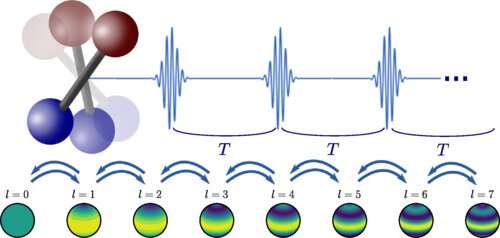Topological charges of periodically kicked molecules

The peculiar topological properties of some forms of matter have been researched for decades. Now, researchers at the Institute of Science and Technology Austria (ISTA) have discovered topological properties of simple diatomic molecules driven to rotation by laser pulses.
The scientists apply similar mathematics to describe them as for solid matter systems, thus bridging two different fields of physics. Their findings promise possible applications in chemistry.
Sometimes, unforeseen connections between disparate research fields in physics can emerge. This is the case for the topological properties of quantum states in rotating molecules.
In a new study, Ph.D. student Volker Karle, Postdoc Areg Ghazaryan, and Professor Mikhail Lemeshko from the Institute of Science and Technology Austria (ISTA), have now revealed that a simple rotating molecule made from just two atoms can feature quantum states with topological properties, similar to what happens in graphene and other solid-state topological materials.
“The interesting thing is that these two systems—a single rotating molecule and a solid sheet of graphene made from millions of carbon atoms—are very different and yet, some of their properties can be described by similar mathematics,” Karle explains. “We are building a bridge between the fields of physical chemistry and solid-state physics.”
The three researchers published their new findings in the journal Physical Review Letters.
A doughnut stays a doughnut
“Topology is the study of the geometrical properties of an object which are unaffected by the continuous change of its shape and size. Realizing that one can classify quantum states not only by their energy and symmetry but also by their topology led to a real breakthrough in our understanding of solid-state physics in the last decades,” Lemeshko explains.
“A simple example of a topological property would be a doughnut. From a mathematical perspective, a doughnut is just a ring with one hole,” Karle adds. “No matter how you stretch or squeeze it, it remains a doughnut as long as you do not do anything as drastic as adding or removing a hole. The property of being a doughnut is therefore topologically protected from ‘small’ disturbances like changing its shape or size.”
In systems like topological insulators, these topological effects emerge from the effects of millions of atoms interacting with one another. However, Karle, Ghazaryan, and Lemeshko have shown that this kind of phenomenon can also be found in much simpler systems like a single molecule.
Pushing a molecule with laser light
“The system we are studying is a single molecule formed by two atoms bonded together,” Karle says. The researchers created a model that describes what happens in such a molecule being pushed by short laser pulses to make it rotate around the midpoint between the two atoms. “At just the right wavelength and timing of the laser pulses, we can create topologically nontrivial quantum states in the molecule that behave like to ones found in solid-state systems.”
For decades now, scientists have studied the topological properties of many different materials and systems—even leading to a Nobel Prize in 2016. However, finding them in a system like a simple molecule allows for new kinds of experiments and applications.
“We are envisioning an experiment where a stream of such molecules is being shot out of a source and then hit with laser pulses,” Karle says. “They then fly into a detector where we can study their quantum states in much greater detail than what’s possible with solid-state systems.” The researchers hope to gain many more insights from future experiments perhaps laying the foundations for new applications in chemistry.
Controlling reactivity
Non-trivial topological properties, like the ones described in this new publication, could lead to topologically protected quantum states. These are especially interesting for any application that needs to be resilient against outside disturbances like heat, magnetic fields, or material impurities. A well-known example that has garnered lots of research interest during the last few years are quantum computers based on topological quantum bits.
However, the molecules that Karle and his colleagues are studying would find different applications. “We hope that this research will allow us to better understand many chemical reactions and may one-day lead to new ways of controlling them,” Lemeshko says. “We could use lasers to create topologically protected quantum states in molecules that increase or decrease their reactivity with other chemicals just as we need it. The topological protection would stabilize the quantum state of the molecule which would otherwise quickly vanish.”
More information:
Volker Karle et al, Topological Charges of Periodically Kicked Molecules, Physical Review Letters (2023). DOI: 10.1103/PhysRevLett.130.103202
Citation:
Topological charges of periodically kicked molecules (2023, March 10)
retrieved 10 March 2023
from https://phys.org/news/2023-03-topological-periodically-molecules.html
This document is subject to copyright. Apart from any fair dealing for the purpose of private study or research, no
part may be reproduced without the written permission. The content is provided for information purposes only.
For all the latest Science News Click Here
For the latest news and updates, follow us on Google News.

